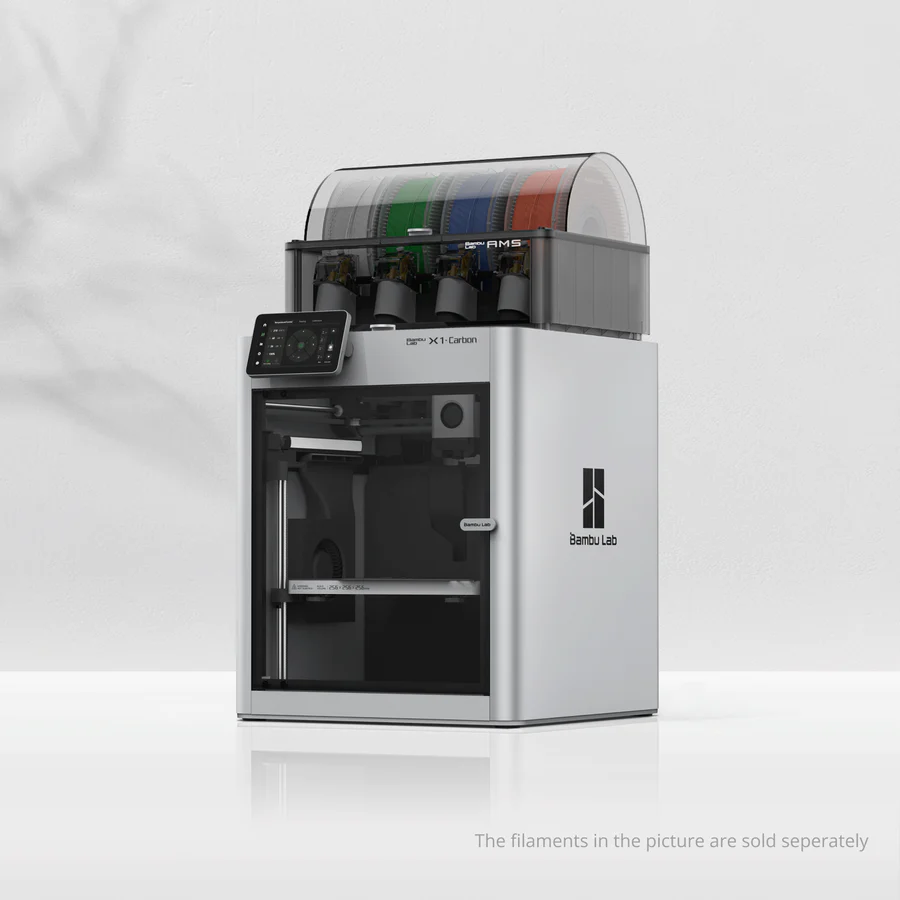Compare KP3S PRO V2 vs X1 carbon
Comparison between the best 3D printers
Choose the best 3D printer at the best price. The cheapest 3D printers are here.
Buy a 3D printer here with 3D Fila.
 |
 |
|
| Model | KP3S PRO V2 |
X1 carbon |
| Printing Material | Filament | Filament |
| Buy Filament for Kingroon KP3S PRO V2 | Buy Filament forBambu Lab X1 carbon | |
| Estimated price | $229,00 | $1449,00 |
| Manufacturer | Kingroon | Bambu Lab |
| Release Year | 2024 | 2023 |
| Print Volume [mm] | 220x220x250 | 256x256x256 |
| Printer Size [mm] | 420x400x450 | 389x389x457 |
| Weight [kg] | 12,6 | 14,13 |
| Power Loss Recovery | NO | YES |
| Enclosed printer | NO | YES |
| Bed Leveling | Automatic | Automatic |
| Filament End Sensor | NO | YES |
| Bed type | Heated | Heated |
| Power supply system | Direct Drive | Direct Drive |
| Standard nozzle | 0,4 | 0,4 |
| Maximum Nozzle Temperature [°C] | 260 | 300 |
| Maximum Bed Temperature [°C] | 100 | 120 |
| Maximum printing speed [mm/s] | 350 | 500 |
| Filament holder | YES | YES |
| Camera for supervision | NO | NO |
| Recommended filaments | PLA, PETG, TPU | PLA, PETG, TPU, PVA, PA, PA-CF, Nylon, PC |
| Recommended slicers | Cura, Orca Slicer | Bambu Studio, Super Slicer, Cura, Prusa Slicer, Orca |
| Maximum Resolution [mm] | 0,01 | 0,1 |
| Processor | Quad ARM A7 1.2 GHz | |
| Display | LCD Mono | Touchscreen 5'' |
| Power Supply | 300 W | 350 W |
| Connectivity | USB-C / MicroSD / Ethernet | Wifi, Bambu bus, Cartão SD |
| Operating systems | Windows, Mac, Linux | Windows, Linux, Macbook |
| Date of registration in the system | 2025-03-18 | 2024-04-10 |
| Release date | 2024 | 2023 |
| Extra features | The Kingroon KP3S Pro V2 is a high-speed FDM 3D printer with Klipper firmware, ensuring fast and precise prints. It features linear rails on all axes, a Direct Drive extruder with a 9.5:1 gear ratio, and an efficient ceramic heater. It includes an inductive sensor for automatic bed leveling, a PEI magnetic bed, a built-in accelerometer for vibration calibration, and Wi-Fi, Ethernet, and USB connectivity for remote control. | The Bambu Lab X1 Carbon revolutionizes 3D printing with stunning design, high print speeds, and a streamlined user experience. It stands out with its CoreXY system, a hotend capable of reaching 300°C, allowing for a wide range of filaments. Its LiDAR-assisted bed leveling system, vibration compensation, and AMS multicolor printing capability raise the industry standard. Print quality is impressive, with the ability to fine-tune for perfection. The X1 Carbon, with its closed build volume, not only promises but also delivers one of the most advanced 3D printing experiences available to consumers. |
| Support for multiple colors and materials (AMS and CFS) | NO | YES |
Notes * |
||
| Cost-benefit | 7 / 10 | 7 / 10 |
| Hardware | 0.9 / 10 | 6.4 / 10 |
| Tela | . | . |
| Print volume | 3 / 10 | 4 / 10 |
| Performance | 3 / 10 | 4 / 10 |
Conclusion |
| In conclusion, the Kingroon KP3S Pro V2 and the Bambu Lab X1 Carbon represent two distinct approaches to 3D printing, catering to different audiences and needs. The KP3S Pro V2 is positioned as a budget-friendly option, offering solid features such as automatic bed leveling and a decent print volume, while being lightweight and compact. Its straightforward design and lower price point make it a suitable choice for hobbyists and those new to 3D printing who prioritize cost-effectiveness. Conversely, the X1 Carbon justifies its higher price with advanced features and capabilities, like a closed build volume, enhanced temperature range, and superior print speeds. This printer is designed for users seeking high performance and versatility, supporting a wider array of materials and delivering exceptional print quality. Its robust features, including LiDAR-assisted bed leveling and multicolor printing, position it at the forefront of 3D printing technology. Ultimately, the choice between these two models hinges on the user’s budget and requirements. For those who value affordability and simplicity, the KP3S Pro V2 is an excellent entry-level option. On the other hand, serious enthusiasts and professionals who require advanced functionality and the ability to work with various materials will find the Bambu Lab X1 Carbon a worthwhile investment. Both printers exhibit commendable performance in their respective categories, earning equal marks for cost-benefit considerations despite their differing approaches. |

